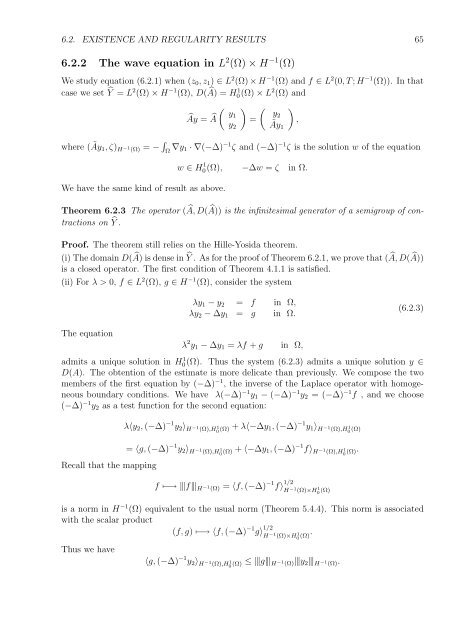Optimal Control of Partial Differential Equations
Optimal Control of Partial Differential Equations
Optimal Control of Partial Differential Equations
Create successful ePaper yourself
Turn your PDF publications into a flip-book with our unique Google optimized e-Paper software.
6.2. EXISTENCE AND REGULARITY RESULTS 65<br />
6.2.2 The wave equation in L 2 (Ω) × H −1 (Ω)<br />
We study equation (6.2.1) when (z0, z1) ∈ L 2 (Ω) × H −1 (Ω) and f ∈ L 2 (0, T ; H −1 (Ω)). In that<br />
case we set Y = L 2 (Ω) × H −1 (Ω), D( A) = H 1 0(Ω) × L 2 (Ω) and<br />
where ( Ãy1, ζ) H −1 (Ω) = − <br />
Ay = <br />
y1<br />
A<br />
y2<br />
We have the same kind <strong>of</strong> result as above.<br />
<br />
=<br />
y2<br />
Ãy1<br />
<br />
,<br />
Ω ∇y1 · ∇(−∆) −1 ζ and (−∆) −1 ζ is the solution w <strong>of</strong> the equation<br />
w ∈ H 1 0(Ω), −∆w = ζ in Ω.<br />
Theorem 6.2.3 The operator ( A, D( A)) is the infinitesimal generator <strong>of</strong> a semigroup <strong>of</strong> contractions<br />
on Y .<br />
Pro<strong>of</strong>. The theorem still relies on the Hille-Yosida theorem.<br />
(i) The domain D( A) is dense in Y . As for the pro<strong>of</strong> <strong>of</strong> Theorem 6.2.1, we prove that ( A, D( A))<br />
is a closed operator. The first condition <strong>of</strong> Theorem 4.1.1 is satisfied.<br />
(ii) For λ > 0, f ∈ L 2 (Ω), g ∈ H −1 (Ω), consider the system<br />
The equation<br />
λy1 − y2 = f in Ω,<br />
λy2 − ∆y1 = g in Ω.<br />
λ 2 y1 − ∆y1 = λf + g in Ω,<br />
(6.2.3)<br />
admits a unique solution in H 1 0(Ω). Thus the system (6.2.3) admits a unique solution y ∈<br />
D(A). The obtention <strong>of</strong> the estimate is more delicate than previously. We compose the two<br />
members <strong>of</strong> the first equation by (−∆) −1 , the inverse <strong>of</strong> the Laplace operator with homogeneous<br />
boundary conditions. We have λ(−∆) −1 y1 − (−∆) −1 y2 = (−∆) −1 f , and we choose<br />
(−∆) −1 y2 as a test function for the second equation:<br />
Recall that the mapping<br />
λ〈y2, (−∆) −1 y2〉 H −1 (Ω),H 1 0 (Ω) + λ〈−∆y1, (−∆) −1 y1〉 H −1 (Ω),H 1 0 (Ω)<br />
= 〈g, (−∆) −1 y2〉 H −1 (Ω),H 1 0 (Ω) + 〈−∆y1, (−∆) −1 f〉 H −1 (Ω),H 1 0 (Ω).<br />
f ↦−→ |f| H −1 (Ω) = 〈f, (−∆) −1 f〉 1/2<br />
H −1 (Ω)×H 1 0 (Ω)<br />
is a norm in H −1 (Ω) equivalent to the usual norm (Theorem 5.4.4). This norm is associated<br />
with the scalar product<br />
(f, g) ↦−→ 〈f, (−∆) −1 g〉 1/2<br />
H −1 (Ω)×H 1 0 (Ω).<br />
Thus we have<br />
〈g, (−∆) −1 y2〉 H −1 (Ω),H 1 0 (Ω) ≤ |g| H −1 (Ω)|y2| H −1 (Ω).

















